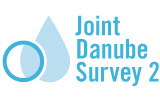Danube 50-day river expedition successfully completed
VIENNA, 28 September 2007 - The Joint Danube Survey 2 today concluded its river research expedition for 2007, and reached its final stop in Tulcea, Romania. The survey was launched mid-August from Regensburg, Germany with three ships that travelled down the entire length (2,375 km) of the Danube.
The goal of the Joint Danube Survey 2 (JDS2) is to produce comparable and reliable information on water quality for the entire Danube and many of its main tributaries. This will help Danube countries implement the Danube River Protection Convention, which they signed in 1994, and the EU Water Framework Directive -- possibly the strongest water legislation in the world.
“All 124 of the pre-selected sampling sites along the Danube and its main tributaries were successfully sampled,” said JDS2 Team Leader Béla Csányi. “This was despite conditions on the water that were often unexpected and extremely difficult for the scientific team and crews.” These included the cold, heavy rain and winds, equipment problems, low and high water levels and unfriendly vessels passing the JDS2 ships.
“Many national governments, scientific organizations, universities, private companies, NGOs and individuals contributed significantly,” said Philip Weller, Executive Secretary of the International Commission for the Protection of the Danube River (ICPDR), the organization coordinating JDS2. “Without their help, the survey would not have been such a great success.”
Some preliminary results have been determined, such as for nutrients through analyses performed on-board the JDS2 research vessel Argus. They show that the general concentration level of nitrates is slightly higher than those observed during the first JDS in 2001, and the level of phosphates is lower. Nonetheless, Danube water meets ICPDR quality targets for both nitrates and phosphates based on results available until now. However, the situation in the Danube’s tributaries is often more critical, especially in the middle and lower parts of the Danube. Pollution from big cities also continues to be a high risk factor for the Danube.
While some samples were tested on-board, many others were sent to scientific laboratories across Europe to be tested for numerous parameters, from toxic pesticides and pharmaceutical drugs to heavy metals and bacteria. A thorough biological analysis in line with the EU Water Framework Directive was performed including the first fish monitoring done along the entire Danube. Many sections demonstrated a healthy status of biological communities for fish, aquatic plants and river-bed dwelling animals.
This was also the first time that the Danube’s hydromorphology (river’s physical characteristics) and ecotoxicology were systematically tested on this scale.
“The amount of additional data and information that will result from the JDS2 is quite incredible,” said Mr. Weller. “Besides chemical, biological and physical data, we will also have a database of over 10,000 photographs. New techniques and technologies were tested for the first time – many of which could make the work of scientists across the globe more accurate and faster.”
Besides testing water, the three ships and their crews stopped at many cities along the way. Here, in cooperation with local and national representatives, they raised awareness about the Danube and the need to clean up pollution. “The stops made by the ships at Danube cities were met by warm welcomes, press conferences and public events,” says Lucia Ana Varga, ICPDR President 2007 and Romanian State Secretary in the Ministry of Environment and Sustainable Development. “The news reached the biggest newspapers and radio and TV stations in each country, so that more people than ever now know about the importance of the Danube and what their governments are doing to improve the situation. Posting the daily results and experiences of the teams onto the special website also helped raise public awareness and keep people informed.”
In about six months time, the results from all analyses will be reviewed, and findings will be reported to the Danube country governments. “The ministries will then be in a much better position to decide on what measures they will need to do to address the pollution and other problems of the Danube River Basin,” said Mr. Weller. “The final conclusive results will be reported to the public next spring.”
Special JDS2 Website
The ICPDR JDS2 website includes the latest scientific results, maps, photographs and short stories from people taking the cruise, presenting a travel blog of interesting and timely facts and experiences from on board the ships beamed electronically to the ICPDR webmaster in Vienna. It also includes detailed Fact Sheets on topics such as the full JDS2 route and the scientific results from the JDS1 (see www.icpdr.org/jds).
For further information, please contact:
Ms. Jasmine Bachmann
Secretariat of the International Commission for the Protection of the Danube River (ICPDR)
Email: jasmine.bachmann@unvienna.org
Mobile: +43 (0)676 845 200-220
Disclaimer
The information contained in the ICPDR website is intended to enhance public access to information about the ICPDR and the Danube River. The information is correct to the best of the knowledge of the ICPDR Secretariat. If errors are brought to our attention we will try to correct them.
The ICPDR, expert group members, nor other parties involved in preparation of information contained on this website cannot, however, be held responsible for the correctness and validity of the data and information provided, nor accept responsibility or liability for damages or losses arising directly or indirectly from the use of the information conveyed therein.
Only those documents clearly marked ICPDR documents reflect the position of the ICPDR.
Any links to other websites are provided for your convenience only. The ICPDR does not accept any responsibility for the accuracy, availability, or appropriateness to the user's purposes, of any information or services on any other website.
When using the information and material provided on this website, credit should be given to the ICPDR.

